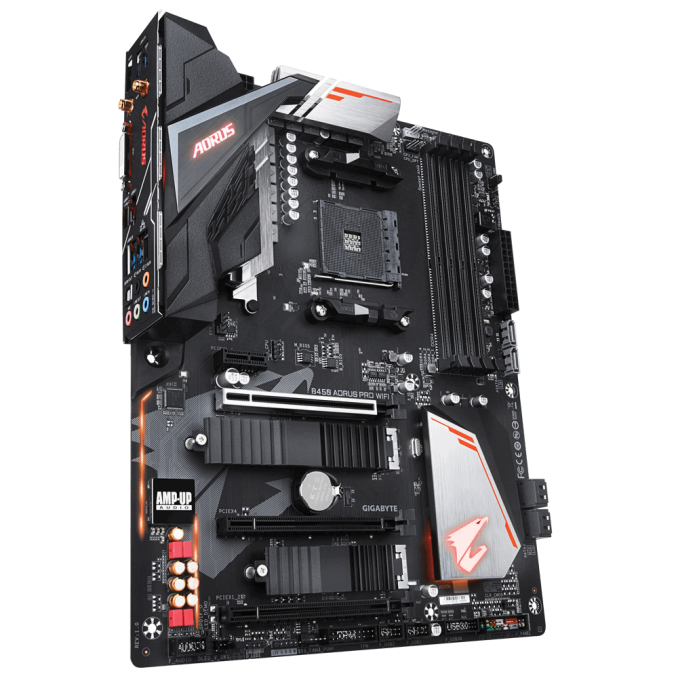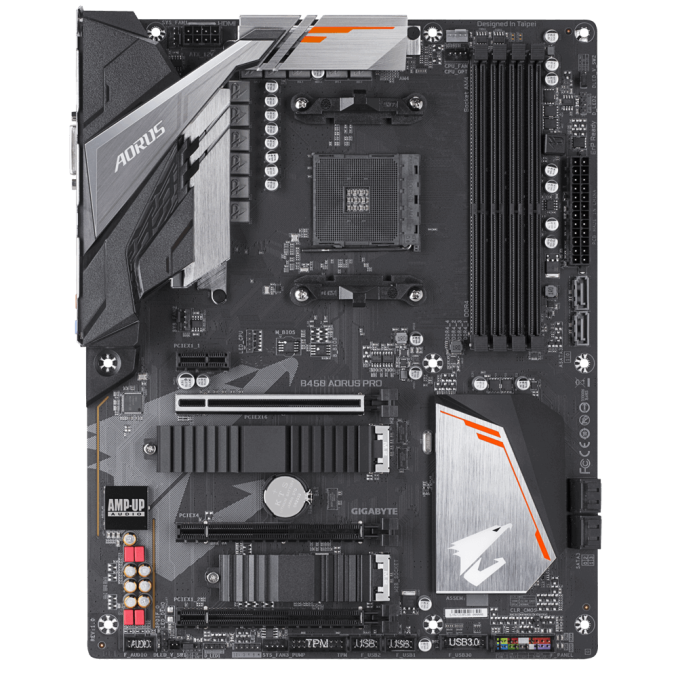Analyzing B450 for AMD Ryzen: A Quick Look at 25+ Motherboards
by Gavin Bonshor on July 31, 2018 8:00 AM ESTGIGABYTE B450 Aorus Pro &
GIGABYTE B450 Aorus Pro WIFI
Both the B450 Aorus Pro and B450 Aorus Pro WIFI models feature near identical PCBs and featuresets, with the main differences being that the WIFI model has an integrated Intel dual-band 802.11ac Wi-Fi module. This also gives the B450 Aorus Pro WIFI the added benefits of Bluetooth 4.2 support.
The B450 Aorus Pro WIFI sits as the premium board from GIGABYTE’s B450 Aorus gaming line-up. The PCB has a black base color with the Aorus falcon in grey towards the PCIe section of the board. Due to GIGABYTE RGB Fusion and implemented RGB LEDs within the power delivery and chipset heatsinks, users have the option to customize the look of their system depending on how they feel; this is also supplemented by additional room for expansion due to an included RGBW LED strip header. Both the power delivery and chipset heatsinks have a metallic grey finish with orange accents which falls in lines with the Aorus branding regime.
Focusing on the PCIe real estate on offer across both models, the Aorus Pro/Pro WIFI feature a full-length PCIe 3.0 x16 slot with a reinforced metal coating to protect the slot from physical damage associated with heavy graphics cards, especially during transit. A further full-length PCIe 2.0 x4 slot sits below which shares bandwidth across both of the PCIe 2.0 full-length slots. This will operate at PCIe 2.0 x2 when either of the PCIe x1 slots is populated, with bottom full-length slot operating at PCIe 2.0 x1. Due to the PCIe configuration on offer, both AMD Quad-GPU CrossFire and dual CrossFire multi graphics cards configurations are supported; NVIDIA SLI multi-card setup aren’t supported on any of GIGABYTE’s B450 motherboard range.
The memory capabilities of both GIGABYTE B450 Aorus Pro and Pro WIFI models include support for DDR4-3200 memory with a total of 64 GB of memory supported across a total of four slots. There is support for both ECC Un-buffered and non-ECC Un-buffered memory with modules supporting XMP memory profiles also being catered for. Both models also feature DualBIOS via two installed 128 Mbit flash chips.
Both models have six SATA ports on offer with the SATA being split into two sections; four right-angled and two straight angled connectors, the latter being located more towards the single 24pin ATX power input for delivering power to the motherboard. The SATA ports across both boards have support for RAID 0, 1 and 10 arrays. In addition to the SATA ports, both the B450 Aorus Pro and Aorus Pro WIFI has a pairing of M.2 slots, with most northernly slot featuring support for PCIe 3.0 x4, and the bottom slot having support for up to PCIe 3.0 x2. In terms of sizing, the top slot has support for drives up to a size of M.2 22110 (22 x 110 mm) and the bottom slot up to M.2 2280 (22 x 80 mm); both slots have support for both PCIe and SATA M.2 SSDs. Both M.2 slots are supplemented with a pair of M.2 thermal guards designed to help dissipate heat from those hot running M.2 SSDs.
A total of five 4-pin fan headers are located around the PCB with one being dedicated for the CPU fan, one dedicated to a water cooling CPU fan, two being devoted as system fan headers and the last being committed to either a system fan or a water cooling pump. In addition to the single RGBW LED strip header, a secondary strip designed for the CPU cooler LED also doubles up as a regular RGB LED strip header giving even more design combinations thanks to the multi-zoned RGB already implemented across both boards. A single 24-pin ATX power input is present to power the motherboard and chipset, with an 8-pin ATX 12 V input dedicated to supplying power to the CPU.
Touching on the power delivery, both models from quick glance look to feature the same hybrid digital VRM as the microATX B450 Aorus M motherboard and keep the configuration consistent across the majority of the mid-range from GIGABYTE. Both B450 Aorus Pro and the Aorus Pro WIFI share the same power delivery heatsink which has a grey metallic finish, with orange accents.
Another prevalent section of both boards is the audio section of the PCB. Both boards consist of a single Realtek ALC1220-VB audio codec, with seven Nichicon Chemicon audio capacitors and four Hi-Fi grade WIMI FKP2 audio capacitors. There is also an element of PCB separation present which is signified by an LED track along the edge of the audio area.

B450 Aorus Pro WIFI rear panel at the top, B450 Aorus Pro at the bottom.
On the rear panels of both boards, the only difference between the B450 Aorus Pro and Aorus Pro WIFI is the WIFI model has adapters present to install the Intel dual-band 802.11ac WiFi, which also includes Bluetooth 4.2 connectivity. The USB connectivity consists of four USB 3.1 5Gbps ports, with two USB 3.1 10 Gbps ports consisting of both a Type-A and a Type-C port; the USB 3.1 10 Gbps ports can be distinguished easily as the ports are colored red. Also included is a single LAN port controlled by an Intel I211-AT Gigabit networking chip, with six 3.5mm audio jacks and a single S/PDIF optical output being driven by the newer Realtek ALC1220-VB audio codec. Finishing off the rear panel on both these B450 Aorus Pro motherboards is a pairing of video outputs; a single HDMI and DVI-D output.
It’s apparent that both these boards are targeted at gamers looking for more premium features from a motherboard such as quality onboard audio and Gigabit networking capabilities but without breaking into the realms of high-end pricing. The B450 Aorus Pro WIFI going one step further and offering 802.11ac Wi-Fi and Bluetooth 4.2 connectivity on top for a stonking price of $119.99. The price for the non-WIFI version of the B450 Aorus Pro hasn't been revealed as of yet, but is expected to be $10-$15 cheaper.



_thumb.png)
_thumb.png)
_thumb.png)
_thumb.png)
_thumb.png)
_thumb.png)

_thumb.png)
_thumb.png)
_thumb.png)
_thumb.png)
_thumb.png)
_thumb.png)








62 Comments
View All Comments
T1beriu - Tuesday, July 31, 2018 - link
Gavin, you made a table that shows B350 and A320 don't support PB2 and XFR2. This is incorrect. Raven Ridge (2400G, 2200G, 2X00U) work without a problem on these boards. Yes, Raven Ridge has PB2 and XFR2 from day one. AMD advertised it when they launched RR last year.https://www.amd.com/en/technologies/sense-mi
Ian Cutress - Tuesday, July 31, 2018 - link
It's not natively enabled from launch - it requires a BIOS update which not all vendors on all boards have provided. The CPUs work sure, but not all features of the CPUs will work in all products.T1beriu - Tuesday, July 31, 2018 - link
PB2 and XFR work on A320 as well.MrbigN - Wednesday, January 23, 2019 - link
If you buy the boards directly from there amazon store or on there website they should be Stock updated.As of, Jan,23 2019
bull2760 - Tuesday, July 31, 2018 - link
Please fix your charts. PCIe should be 3.0 not 2.0Ian Cutress - Tuesday, July 31, 2018 - link
The Chipset supports PCIe 2.0 lanes. PCIe 3.0 lanes come from the CPU.chrcoluk - Monday, August 30, 2021 - link
yeah but the 2nd x16 slot is also from the cpu and thus 3.0, you can even choose to make it a 8x slot in the bios by downgrading the first slot to 8x.The review incorrectly states the second full length slot is only 2.0.
T1beriu - Tuesday, July 31, 2018 - link
StoreMI can work on 300-series motherboards but comes with an additional fee (I don't think it's BIOS dependent).https://www.amd.com/en/technologies/store-mi
Ian Cutress - Tuesday, July 31, 2018 - link
The systems support 10 GbE, if you buy the cards. Yes it's picking hairs, but we're speaking native support.jtd871 - Tuesday, July 31, 2018 - link
What does 10GbE have to do with StoreMI?!